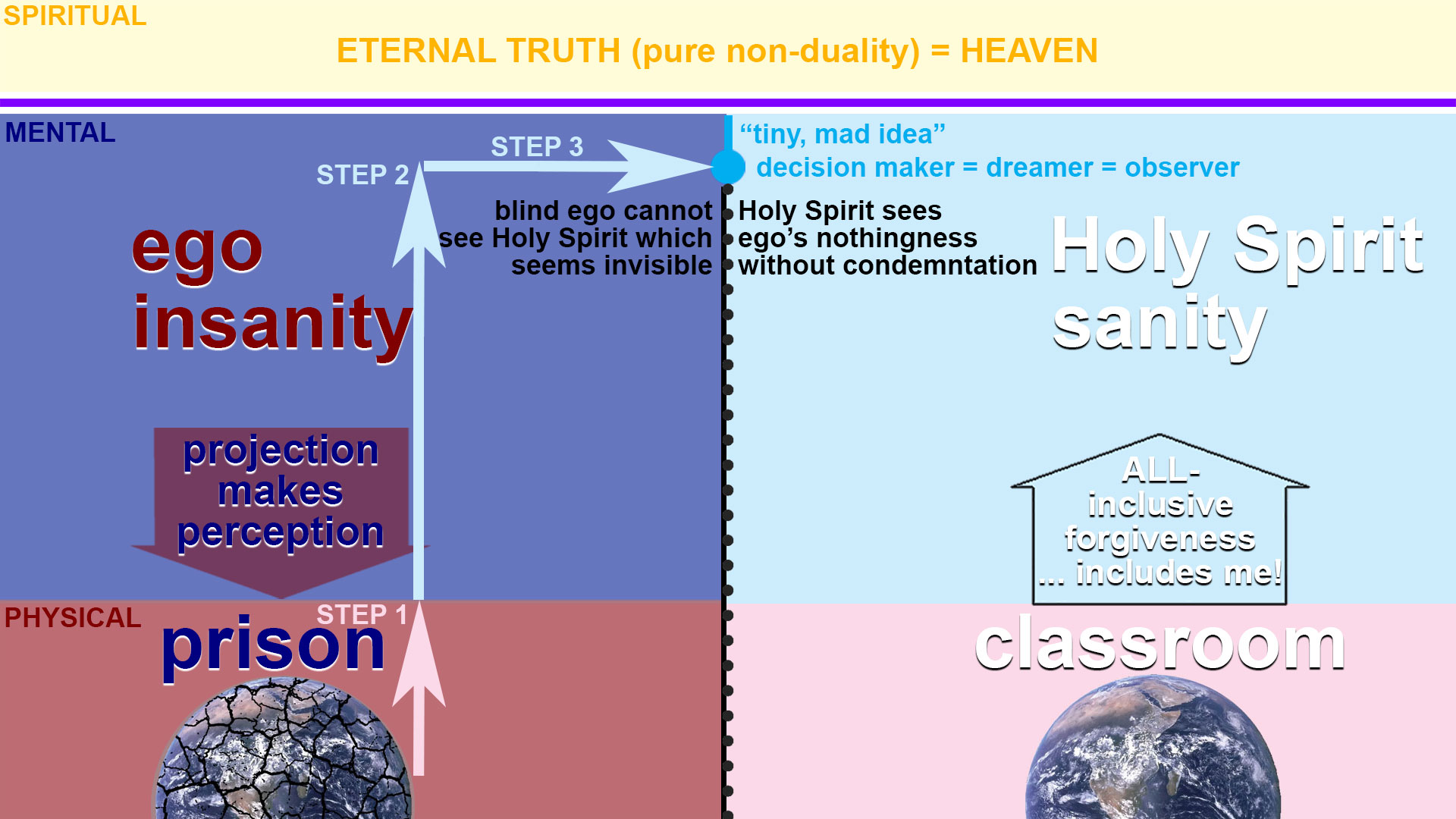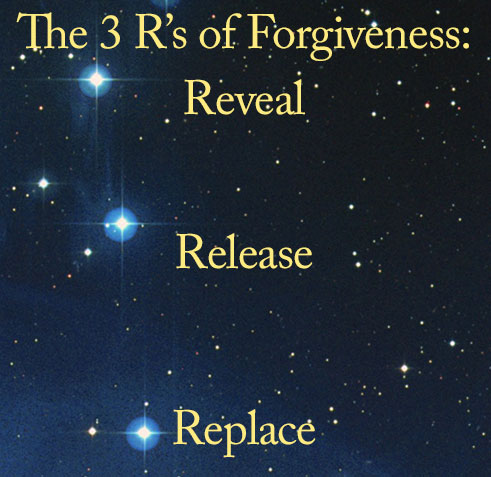 The process of true forgiveness in A Course In Miracles is described in a single sentence in Workbook Lesson 23:
The process of true forgiveness in A Course In Miracles is described in a single sentence in Workbook Lesson 23:
“This change requires, first, that the cause be identified and then let go, so that it can be replaced.” (W-23.5:2)
Here’s the full paragraph for context:
“The idea for today introduces the thought that you are not trapped in the world you see, because its cause can be changed. This change requires, first, that the cause be identified and then let go, so that it can be replaced. The first two steps in this process require your cooperation. The final one does not. Your images have already been replaced. By taking the first two steps, you will see that this is so.” (W-23.5:1-6)
It is such a short, concise sentence that one might miss the profound yet simple process if you blink or read it too quickly! In a prior post “Three R’s of Forgiveness: Workbook Lesson 23” we outlined one way of looking at these 3 steps with an alliterative mnemonic of “Reveal, Release and Replace” which can be linked to the 3 phrases above:
- Reveal (or Realize): I identify the cause as not being outside in the material world, including my body/brain or anyone else’s, what “they” say or do – or don’t say or don’t do. This is the outer shield of oblivion and metaphorically the closed drawbridge of the ego’s castle by which it excludes any thoughts of kindness, sameness, and forgiveness. By making sure I don’t include others in our definition of “self” I maintain the belief in separation; put another way, our identity is framed by a (silly, seemingly separate) self that excludes everyone and everything else, with its “poster child in our (ego) mind being the body. If I consider that “we’re all in the same boat” metaphorically, I reframe (another alternate to the first of the 3 R’s) by extending our definition of Self (even if not fully complete yet) to include the “others” I might have previously excluded with grievances, attacks, and special love/hate bargains. Workbook Lesson 5: “I am never upset for the reason I think.” (W-5) is an excellent practice to invite our Inner Kindness Teacher (a.k.a. Holy Spirit) to help us with the necessary mindfulness to go beyond the external after carefully considering and concluding that our lack of peace is never due to what seems to be happening or not happening in our space-time dreams.
- Release: Now that I’ve broached the outer defense of the ego’s thought system and returned from the world to the mind, the ego goes from “yellow to red alert” since I’m still trying to get rid of the now conscious guilt and ego becomes desperate to usher us outside the nightmarish thought system in our mind where only sin, guilt and fear (or their numerous equivalents) appear to reside. To do this, it will redouble its efforts to keep us blindsided by physical events that demand our attention or whatever it can muster to distract or divert our awareness. As the Wizard of Oz said, “Pay no attention to that man behind the curtain” as our inner “Toto” – en toto means all-encompassing in Latin – shows us that our fears fomented from unfounded guilt based on the faulty premise and forgivable misinterpretations ego’s propaganda of sin. “You have been told to bring the darkness to the light, and guilt to holiness. And you have also been told that error must be corrected at its source.” (T-18.IX.1:1-2) Because our own mental self-assessment – identified as a (silly, seemingly separate) self – is “the home of evil, darkness and sin” (W-93.1:1) I again need Holy Spirit’s help see that the guilt is not inside either… to undo or let go of the wretched image of myself; I need to consider (as I now broach the inner shield of oblivion) that insight provided by Workbook Lesson 34: “I could see peace instead of this.” (W-34) When we reach the most heavily defended citadel in ego’s thought system – the metaphoric “castle keep” of sin in ego’s fortress of mindlessness, we have arrived at the “blue dot” in Ken Wapnick’s wonderful metaphysical charts – the decision-maker. This is the “malware” in our mind’s computer that we eradicate via forgiveness. The ego thought system was made up here as the tiny mad idea was believed to be true; its unquestioned cause was all that seemed to maintain the nightmare world of separate thoughts and projected bodies. When we switch to the Holy Spirit’s thought system, we restore and run the original sane, peaceful software of “Nothing Happened,” “Minds Are Joined,” and “Ideas Leave Not Their Source” which wakes us up from ego’s trifling cause and its seemingly heavy consequences.
- Replace: Because my real identity – identical to that of everyone “else” is already innocent, when I listen to Holy Spirit and allow that guidance through the first two steps, the replacement is automatic. Truth has no opposite and needs no defense. I have let go of those exhausting mental defenses of ego doggedly defending lies with more lies and now peace floods back into my awareness.

In this process, I go from unconscious, unfounded (seemingly external) projected guilt to conscious, internalized, uncomfortable guilt, and then (realizing that the guilt has no basis in truth I release it and it is automatically replaced with the eternal peace that is our eternal inheritance, destiny, and a defining characteristic of the innocence of our true identity.
Here is an outstanding related article and video by Tim Wise and Lyn Corona of the School For A Course In Miracles on “The Three Steps of Forgiveness in ‘A Course in Miracles’ ” I highly recommend reading this article and watching the video to get a more complete idea of true forgiveness with generous examples of ACIM’s process and how we apply it by asking for help from the Course’s Jesus a.k.a. Holy Spirit. These are other examples of true forgiveness in ACIM highlighted in the SFACIM article:
“As I look about, I condemn the world I look upon.I call this seeing.I hold the past against everyone and everything, making them my enemies (STEP ONE).When I have forgiven myself (STEP TWO) and remembered Who I am, I will bless everyone and everything I see.There will be no past, and therefore no enemies.And I will look with love on all that I failed to see before. (STEP THREE)“ (W-52.2:2-7)
“Recognizing that what I see reflects what I think I am (STEP ONE), I realize that vision is my greatest need.The world I see attests to the fearful nature of the self-image I have made.If I would remember who I am, it is essential that I let this image of myself go (STEP TWO). As it is replaced by truth, vision will surely be given me.And with this vision, I will look upon the world and on myself with charity and love. (STEP THREE)” (W-56.2:2-6)
“I must have decided wrongly, because I am not at peace. (STEP ONE)
I made the decision myself, but I can also decide otherwise.
I want to decide otherwise, because I want to be at peace. (STEP TWO)
I do not feel guilty, because the Holy Spirit will undo all the consequences of my wrong decision if I will let Him.
I choose to let Him, by allowing Him to decide for God for me. (STEP THREE)” (T-5.VII.6:7-11)“Do not be afraid of the ego. It depends on your mind, and as you made it by believing in it, so you can dispel it by withdrawing belief from it.Do not project the responsibility for your belief in it onto anyone else, or you will preserve the belief.When you are willing to accept sole responsibility for the ego’s existence you will have laid aside all anger and all attack, because they come from an attempt to project responsibility for your own errors. (STEP ONE)But having accepted the errors as yours, do not keep them.Give them over quickly to the Holy Spirit to be undone completely (STEP TWO), so that all their effects will vanish from your mind and from the Sonship as a whole. (STEP THREE)” (T-7.VIII.5:1-6)
“This is the shift that true perception brings: What was projected out (STEP ONE) is seen within (STEP TWO), and there forgiveness lets it disappear (STEP THREE). For there the altar to the Son is set, and there his Father is remembered. Here are all illusions brought to truth and laid upon the altar. What is seen outside must lie beyond forgiveness, for it seems to be forever sinful. Where is hope while sin is seen as outside (STEP ONE)? What remedy can guilt expect? But seen within your mind, guilt and forgiveness for an instant lie together, side by side, upon one altar (STEP TWO). There at last are sickness and its single remedy joined in one healing brightness (STEP THREE). God has come to claim His Own. Forgiveness is complete.” (C-4.6:1-10)
Here are some additional ACIM references that exemplify the three steps of forgiveness; thanks to fellow Course student, Marisa Cuenin for these:
(The first, third, fourth, and fifth examples from Tim’s list above were also in Marisa’s list.)
“The therapist sees in the patient (STEP ONE) all that he has not forgiven in himself (STEP TWO), and is thus given another chance to look at it, open it to re-evaluation, and forgive it. (STEP THREE)” (P-2.VI.6:3) … “The patient is his screen (STEP ONE) for the projection of his sins, enabling him to let them go (STEP TWO). Let him retain one spot of sin in what he looks upon, and his release is partial and will not be sure.”(P-2.VI.6:6-7)
“Do not assume His function for Him.⁸Give Him but what He asks (STEP ONE), that you may learn how little is your part, and how great is His.” (T-18.IV.6:7-8) … Never attempt to overlook your guilt (STEP TWO) before you ask the Holy Spirit’s help. That is His function. Your part is only to offer Him a little willingness to let Him remove all fear and hatred, and to be forgiven. (STEP THREE) (T-18.V.2:3-5)
“You could, in fact, gain vision from just that table, if you would withdraw all your own ideas from it (STEP ONE), and look upon it with a completely open mind (STEP TWO). It has something to show you; something beautiful and clean and of infinite value, full of happiness and hope (STEP THREE). Hidden under all your ideas about it is its real purpose, the purpose it shares with all the universe.“ (W-28.5:1-3)
To complete an overview of true forgiveness, the first of the “What is…” essays in Part II of the Workbook is also worthy of re-reading frequently, as we did at the beginning of every Tuesday evening in a study group in Phoenix, Oregon for many years:
What Is Forgiveness? (W-pII.1) It begins with: “Forgiveness recognizes what you thought your brother did to you has not occurred. It does not pardon sins and make them real. It sees there was no sin. And in (only) that view are all your sins forgiven.” (W-pII.1.1:1-4)